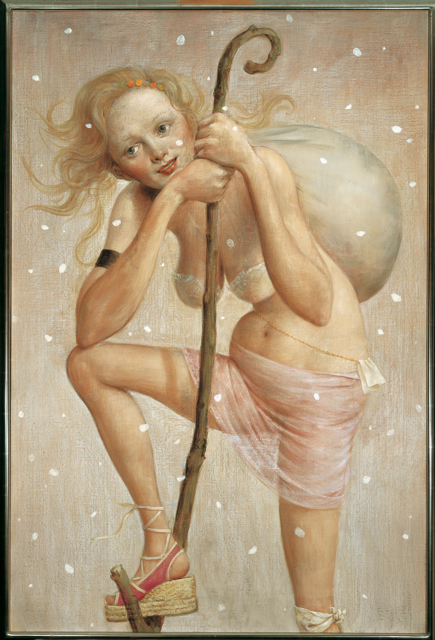Currently on view: Montréal
John Currin
at DHC/ART, Montréal
30 June – 13 November 2011

“Sno-bo” (1999) © John Currin. Courtesy Gagosian Gallery
DHC/ART premiered John Currin with a first retrospective exhibition in Montréal for the American painter. Looking back at the last two decades of his works, displayed chronologically from the lowest level up to the top forth floor of the DHC/ART building, Currin has evolved from somewhat naïve painterly techniques to more recent attempts to rival old-master virtuosities, via provocative erotic themes. Willingly putting high and low brow genres into conflict, he is well known for painting women with disproportionally large breasts, tiny feet and padded bottoms. Currin appropriates kitsch and other popular forms of imagery from mass media consumer culture, to entangle their mercantile origins with satire, caricature, fiction and fantasy. These surprisingly modest-sized canvases also overflow with art historical reference that somehow add gravitas to evermore prodigal pictorial effects, in high contrast to his deliberate choice of shallow subject matter, trespassing on ideas beauty and desire.
Works here on display date back form the 1990s, and “Bea Arthur Naked†(1991) counts as one of Currin’s earliest, portraying the Golden Girls sitcom actress in a flattering birthday suit, which mismatches her usually masculine persona. “Ms. Omni†(1993) also depicts a mature woman, striking a fashion model pose that draws more-than-wanted attention to her wrinkled face, giraffe neck and twiggy figure. Despite a shriveled body, she somehow retains a certain elegance that only elderly ladies of influence may possess. A make-up wearing man gropes from his black gloves the majestic breasts of a rosy-cheeked nubile, in “The Wizard†(1994). Painted, according to Currin, when he met his wife, muse and a fellow artist Rachel Feinstein, both male and female proponents in the latter piece seem enraptured in a mutual moment of contemplation, where the fetish and obscene insinuations are tempered by an aura of calmness. While these early works see Currin experiment brilliantly with impasto and shadowy outlines that remind of Francis Picabia, surely we find his gigantically-boobed girls, stirring outcries from the media, art critiques as well as feminists, as the initial push into the limelight for the Yale MFA graduate.

“Stamford After Brunch” (2000) © John Currin. Courtesy Gagosian Gallery
The marriage and subsequent Italian honeymoon of Currin and Feinstein in 1997, led to the arrival of a new painting style, such as viewed with “Honeymoon Nude†(1998). The figure in this painting clearly reveals Currin’s admiration for Botticelli’s ‘Venus’, short of her girl-next-door facial features, which in fact more resemble his newly wedded wife. Inspired as much by Italian (Botticelli, Titian) as by Northern Renaissance art (Cranach and Durer), Currin revises his brushstrokes to a thinner, feathery touch. His interests also target Rococo tableaux like Boucher’s, oddly populated by disproportionate characters in tiny heads and long legs. These “previews of Barbie dolls” figures emerge in his work as in “Sno-Bo†(1999), the ethereal fairy-like women rendered under his able strokes are exaggerated but not yet freaky, and express irony over the iconographic stereotypes of the desirable lady. The same applies to “Stamford After Brunch†(2000), a mid-scenario snapshot of upper middle class suburban wives, enthralled in gossip over martinis and cigars. However, it would be easy to interpret their humorous but grotesquely balanced body as a comment on the privileged social classes. Another female gathering is depicted in “Thanksgiving†(2003), this time elongated necks and anorexic bodies gather around the fatty voluptuousness of a turkey, which makes for a rather comical contrast. Currin here again alters the treatment of his paintings to 17th century camera obscura realism, as seen with Vermeer or other Flemish and Dutch masters. This meticulous technique is again exemplified in “Rachel in Fur†(2003), by the level of details in the animal hair, the subtlety of a Mona Lisa-like smile, and luminous skin tones.

“Rachel In Fur” (2003) © John Currin. Courtesy Gagosian Gallery
Currin’s 2003 mid-career retrospective traveled at the Whitney Museum of American Art, the Museum of Contemporary Art in Chicago as well as Serpentine Gallery in London. But the success of these shows brought a long, dry, even depressing period to his studio, where he experienced “impotence with the brushâ€. The dry spell was broken accidentally when Currin found a pornographic image on the back of a cartoon page, given to him by his friend. From his start in 2006, explicit imagery kindled by vintage European porn invaded his canvases, as with “Rotterdam†(2006), which progressively turned to soft focused, sensual and romantic imagery, abundant in carefully crafted ornaments like gold chains and pearl necklace, showing their weight against the flesh of Currin’s painted figures. To reiterate this impression of luxuriousness, these paintings are mounted in golden or embellished thick wooden frames.
In his quest to perfect his skills to the age-old ambitions of master-painter, Currin’s style has visited some of the most classic movements of western art, to achieve convincing skin hues and other textures, as well as superior compositions. Such talents still unsuccessfully distract us from Currin’s other achievements, which dwell in the subject matter of his work. Amid an over-sexualized genre that incorporates Courbet’s “L’Origine du Monde†(1866) as much as Jeff Koon’s “Made in Heaven†series (1991), Currin famously described his nude paintings “guaranteed failureâ€, in their potential for arousal. He plays a delicate balance between proficient painterly techniques and scandalous topics, where even pornography shifts from the lowly to lofty edge of art, in a process that renders the whole exercise sterile, or banal. Some may find it stupid to turn in circles and finally amount to nothing, but one suspects that it is in the very stupidity of painting that Currin finds solace.
DHC/ART
451 & 465 St-Jean
Montréal, QC, H2Y 2R5
Canada
+1 514 849 3742
info@dhc-art.org
www.dhc-art.org

One Reply to “Review: John Currin – Controversial ambitions of a master painter”